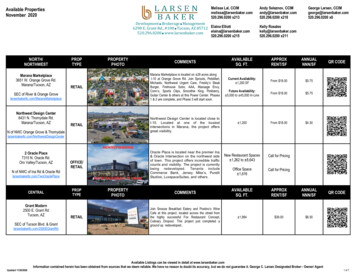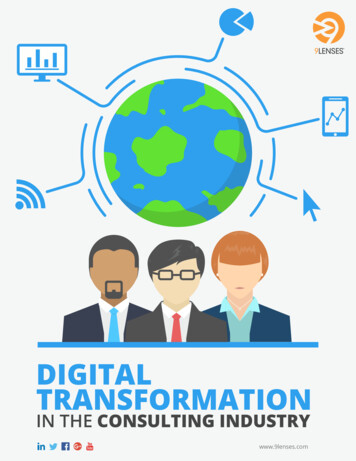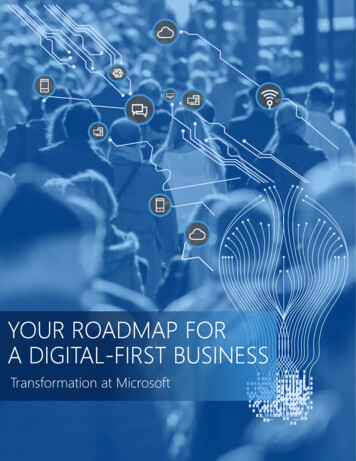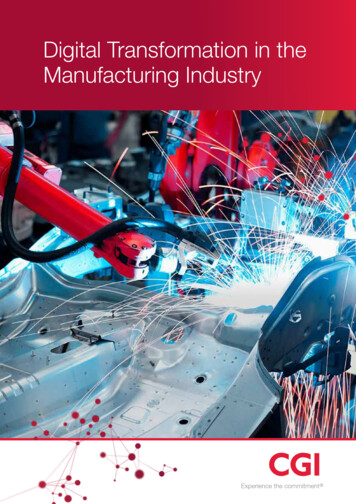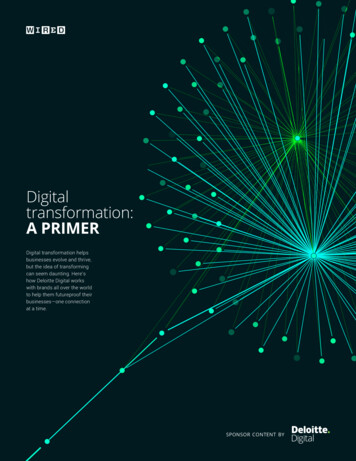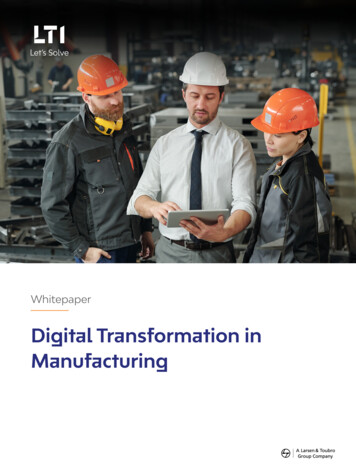
Transcription
WhitepaperDigital Transformation inManufacturing
Digital Transformation in Manufacturing 2Digital Transformation is the need of the hour for all large or small enterprises. Businessesmust learn to be competitive and relevant in this new ecosystem as the worldbecomes increasingly digital. Digital Transformation has become one of the most popularbuzzwords these days. However, many business leaders are still perplexed by what DigitalTransformation actually entails. How to go about doing it? What are the steps to follow inthe transformation process? Is it worth the effort?This paper tries to answer some of the most frequently asked issues about digitaltransformation, focusing on helping manufacturing executives identify the purpose andprocess of digital transformation.The purpose can be segregated into four broader areas:CompetitiveAdvantageNew BusinessModelsCost ReductionAgilityThis paper is broken down into the below sections to provide clarity to executives consideringDigital Transformation in manufacturing and how CXOs can achieve this objective during thisera of disruption.0102Breakingthe MythWhat is Digitaltransformation03Technologiesdriving Digitaltransformation
Digital Transformation in Manufacturing 3Breaking the MythThe rapid rate of change in the technology world has given rise to several deceptive andharmful myths surrounding Digital Transformation in relation to an organization’s overallvision.Myth #1: Digital Transformation is only for large corporations, not small and mediumsized businessesReality: The notion that Digital Transformation is not appropriate for small and mediumsized businesses is a slipup. Of course, the degree of application and adoption will varydepending on the company’s size but failing to embrace digital technologies is a surefireway of going extinct. Instead of simply watching what is happening in the market,companies of all sizes should begin assessing how best they should plan for adoptingdigital technology.Purpose: An increasing number of small-sized manufacturing firms that have implementedDigital Transformation seem to already have a competitive advantage over others.Myth #2: Digital is merely a support function aimed at improving gains marginallyReality: Many companies are moving away from seeing technology solely as a support roleand instead as a revenue generator. Companies that have integrated digital technologiesinto their operations have been effective in increasing efficiencies and diversifying theirrevenue streams, competing against digital natives, and surpassing competitors.So, organizations should take a holistic view and should not consider Digital Transformationas a mere support function.Purpose: Organizations like HILTI have added new business models by adding fleetmanagement to their field service portfolio.Myth #3: Organizations are going to lose employees as a result of digitaltransformationReality: Businesses are better off when they introduce digital technology that supportsand suits the workforce’s existing skills. Technology can automate specific processes, givingemployees more time to focus on strategic work such as creative planning, which can’t bedone with technology.
Digital Transformation in Manufacturing 4Purpose: By adopting digital technologies, organizations reduce the cost of operations andenhance employees’ skills as per the business strategy allowing them to focus on the corebusiness values.Myth #4: The digital agenda is all about ITReality: Thinking of digital technologies as a stand-alone IT agenda without activebusiness involvement or stakeholder participation is as distant a thought from reality as itcan get. The key to Digital Transformation is the convergence of business and technology.Digital technologies can only genuinely contribute value to an organization if businessexecutives understand and collaborate with technology executives. There is no singledigital strategy that will work for all firms that can be implemented by the IT departmentalone. For successful execution, Digital Transformation necessitates rigorous planning andcross-functional participation.Purpose: Firms have become more agile and have drastically increased their speed toresponse by aligning their IT and business strategies to an integrated vision.Myth #5: Digital Transformation can waitReality: When myths like the above hinder an enterprise from taking a leap of faith, it’seasier to put off digital change. However, the longer the delay, the more the businesswill fall behind. Digital Transformation can also be used to respond to changing marketdemands. Loyal customers are intangible assets that contribute significant value to acompany, and their requirements should be satisfied and attended to religiously.Purpose: Organizations such as Kodak made a mistake by not adapting to the digitaldisruption at the right time and thus had to pay a considerable price and in turn, lost theircompetitive advantage.
Digital Transformation in Manufacturing 5What is Digital Transformation?As we have addressed the myths and how technology helps manufacturing organizationsidentify the purpose of any digital transformation, let us now try to answer some commonquestions such as what Digital Transformation is and how it can be incorporated?The integration of technology into all verticals of a business, fundamentally changing howit runs and offers value to customers, is known as Digital Transformation. It also means acultural shift that requires organizations to challenge the status quo and be open tonew ideas.Three Areas of Digital Transformation in ManufacturingAny transformation is only successful if acceptable transformation areas have beenidentified by adopting a strategy that uses technology to improve the ethos that alignswith the business, boosts revenue, and reduces cost.The three categories are:ConnectedManufacturingDataUnificationLagacy ModernizationLegacy ModernizationAnother component of what is holding back many firms today from transformation is thelegacy systems. Legacy systems are prone to be single points of failure. They’re not onlynon-scalable and have limited commercial usefulness but are also expensive to run andhave extensive development cycles. Organizations must examine their IT systems closelyand do a thorough cost-benefit analysis to determine which technologies are effectiveand inefficient. Based on the modernization drivers, they can choose to tolerate, delete,or reform them. The drivers, for example, maybe reducing expenses, increasing efficiency,or compliance. Once the cost-benefit analysis is done, these factors would impact theirpriorities in the phase-wise modernization journey to maximize the benefit and reducethe risk.
Digital Transformation in Manufacturing 6Data UnificationWhen it comes to digital transformation, many companies today contend with data silos asthe principal bottleneck. Consider a company that receives data from various sources andthen organizes it according to function and relevance. Many companies have done it foryears with little consequence until now when everyone is using analytics. Without all thedata being integrated and harmonized, it is impossible to draw meaningful conclusionsand understand the broader picture. Data unification is the first step toward transforminga reactive, intuition-based decision-making system into a proactive, even predictive, anddata-driven decision-making system powered by AI.Connected ManufacturingThe concept of connected manufacturing or the connected factory (one of the essentialtenets of Industry 4.0) is perhaps the most exciting and rewarding of all the transformationinitiatives. This is the point at which you enter a cyber-human environment, where devicesact as your employees, monitor status, analyze patterns, and predict intelligent businessinsights in real-time. By converting real-time data from sensors and devices into actionableinsight, digital technology solutions may help manufacturers become more responsive andpredictive rather than reactive. Such is the digital transformation’s potency and the futurethat Industry 4.0 promises.Support agementProduct andTechnologyDevelopmentPrimary es andMarketingOutboundLogisticsAfter SalesUse CasesUse CasesUse CasesUse CasesUse CasesUse CasesUse CasesUse CasesUse CasesIntelligentConnectedLogistics dataWarehouseCustomerLogistic DataPayrollERPRPA enabledRouteoperations,management,management,360, nning,IntelligentQuote to cashIntelligentmanagement,BOM,Onboarding,DataWO, PO etc.,enhancedassetprocessroutemobile CRMLedger Mgmt.Hiring,Migration.Contract metacarrier 3PLoptimization,automationplanningdata rMaintenanceverification.Mgmt.Value Added
Digital Transformation in Manufacturing 7Technologies Driving Digital ManufacturingAs we understand what Digital Transformation is and where to start, let us look at thetechnology enablers and how the manufacturing industries can adopt these technologies.The technology adoption matrix below talks about the time taken to adopt new technologiesin manufacturing in both the short and the longer term. It helps an organization understandwhere it needs to build its competencies and why, more importantly, how it can align itsmanufacturing processes and overall strategy to Industry 4.0 concepts.Time to AdoptTechnologyEarly Adoptions Connected Factory Worker Digital Twin Smart Factory Digital Supply Chain StrategyCloud Computing inManufacting Operations Immersive Experience inManufacturing Operations Late Adoptions 5G for Manufacturing OperationsIT/OT Convergence and AligmentMachine Learning 3D Printing in ManufacturingOperations Asset Performance ManagementPrescriptive AnalysisTechnology Adoption MatrixAdoption in a Short timea) Digital Twin: A digital twin is a virtual version of an entity, such as an asset, person,or process created to help businesses achieve their goals. Discrete, composite, andorganizational digital twins are the three forms of digital twins. The model, rules,relations, and data attributes are all part of the digital twin class. Model data, uniqueone-to-one association, and monitorability are all elements of a digital twin instance.The adoption of digital twins is in line with Internet of Things (IoT) trends. For equipmentusers in factories, hospitals, utilities, and other facilities, near-term use includesminimizing maintenance costs and enhancing asset uptimes. Product differentiation,business model differentiation through new product-service models, and gatheringcustomer data are all near-term uses for Original Equipment Manufacturers (OEMs).
Digital Transformation in Manufacturing 8Gartner’s 2019 enterprise survey shows that 13% of respondents claim to already usedigital twins, while 62% are either in the process of establishing the technology or planto do so in the next year [4].b) Internet of Things — Manufacturing Operations: The Internet of Things (IoT) is acritical component of digital businesses and platforms. It’s a network of specializedphysical devices with embedded technology that allows communication, detection, andinteraction among similar devices within the system or the outside world.Assets, communication protocols, apps, and data and analytics are all part of theIoT ecosystem. Using IoT to supplement various Operational Technologies (OT) inmanufacturing activities has become a fundamental building component for futuredigital supply chains and smart factories, in line with Industry 4.0 expectations.c) Immersive Experience in Manufacturing Operations: Immersive experience refersto the ability to perceive being physically present in a nonphysical environment orenhancing people’s physical presence with virtual world material. Immersive experiencescan be divided into three categories: Augmented Reality (AR), Virtual Reality (VR), andMixed Reality (MR).COVID-19 has elevated the importance of immersive experience, significantly alteringhow manufacturing workers view and interact with the digital world.Adoption in a long perioda) Machine Learning: Machine learning is possibly the most fantastic thing in the IT worldright now. As an application of artificial intelligence (AI), it allows your system to learn andimprove on its own without having to be explicitly programmed. It makes it possible forsoftware applications to become more accurate in predicting outcomes.Machine learning tools and platforms now assist manufacturers in developing newbusiness models, fine-tuning product quality, and optimizing shop floor processes.The competitive realm of industrial robots provides gains such as minor reductions inequipment failures, better on-time deliveries, equipment enhancements, and fastertraining times.Machine learning (ML) can be used in industrial operations to detect patterns andcorrelations using accessible data and algorithms. They can also forecast outcomes,determine the best courses of action, and manage processes.
Digital Transformation in Manufacturing 9b) 5G for Manufacturing Operations: 5G for industrial operations refers to next-generationmobile broadband and cellular standard data services adapted to the industry’sneeds. 5G covers a spectrum of 3mm wavebands (low, mid, and high frequency).Manufacturing 5G service capabilities will be initially provided through new focusedsupply chain data and communications services offered by Communication ServiceProviders (CSPs).The emergence of 5G for manufacturing activities is still in its early stages. The priorityand allocation of resources for maintaining private/campus 5G networks and larger-scalemobile networks will determine how quickly CSPs can supply certain data services.c) 3D Printing in Manufacturing Operations: In manufacturing, 3D printing (3DP) refersto the use of 3D printers to create a finished object, subassembly, or intermediateproduct. It can also print equipment, fixtures, dies, and molds for completed goods.3D printing allows for increased supply chain mobility, flexibility, and adaptability byenabling consumers to determine demand while lowering prices and waste. Companiesno longer have to gamble on estimating consumer demand; 3D printing gives endlessflexibility to manufacture what is needed.d) Prescriptive Analysis: The term “prescriptive analytics” refers to a collection ofanalytical capabilities that determines the best course of action to achieve a specificgoal, such as increasing revenue or lowering costs. Optimization approaches such aslinear programming, rule-based decision making, and heuristics are the most prevalentinstances of prescriptive analytics. Differing from descriptive, diagnostic, and predictiveanalytics, the objective of prescriptive analytics is a suggested action.Supply chain companies have traditionally utilized prescriptive analytics to handlestrategic or tactical time-horizon concerns, including network architecture, sourcingstrategies, and production planning. Prescriptive analytics is now being used in nearreal-time decision-making in restocking, pricing, and efficient planning.
Digital Transformation in Manufacturing 10ConclusionIn every sector of the economy, Digital Transformation is changing the way people dobusiness. Businesses will need to evolve into digital organizations to succeed, and thistransformation will require far more than simply investing in cutting-edge technology.Digital Transformation is essential for some businesses to stay afloat, and while others maynot go bankrupt without it, they will still have to settle for a low-margin business strategy.Business leaders must move away from industry stereotypes, understand technologies,and help firms ride this wave with a competitive advantage by developing a successfultransformation roadmap.References[1] l-transformation[2] gital-transformation[3] key-towinning-in-the-next-normal/?sh 7b1df5564405[4] ing-mai
Digital Transformation in Manufacturing 11About the AuthorMayank VyasSpecialist - Software Engineering, LTIMayank has 9 years of delivery and consulting experience in theManufacturing sector. He is currently engaged in delivering data-drivenbusiness outcomes for global brands across sales, services, and thesupply chain. He also holds an MBA from IIM Indore.LTI (NSE: LTI) is a global technology consulting and digital solutions Company helping more than 435 clients succeed in aconverging world. With operations in 31 countries, we go the extra mile for our clients and accelerate their digital transformationwith LTI’s Mosaic platform enabling their mobile, social, analytics, IoT and cloud journeys. Founded in 1997 as a subsidiary ofLarsen & Toubro Limited, our unique heritage gives us unrivalled real-world expertise to solve the most complex challengesof enterprises across all industries. Each day, our team of more than 36,000 LTItes enable our clients to improve theeffectiveness of their business and technology operations and deliver value to their customers, employees and shareholders.Find more at http://www.Lntinfotech.com or follow us at @LTI GlobalInfo@lntinfotech.com
mobile CRM. Digital Transformation in Manufacturing 7 Technologies Driving Digital Manufacturing As we understand what Digital Transformation is and where to start, let us look at the . right now. As an application of artificial intelligence (AI), it allows your system to learn and
